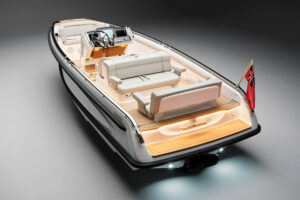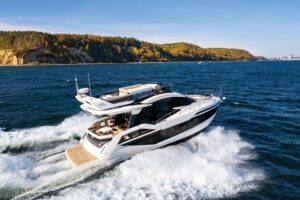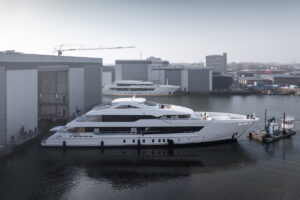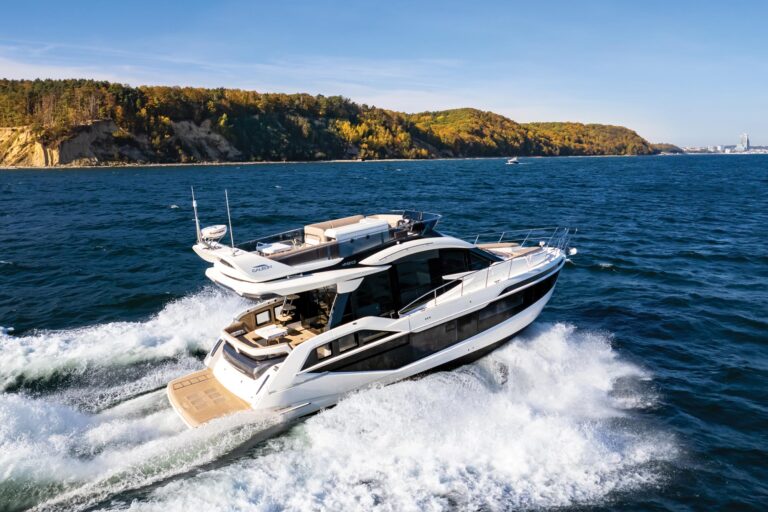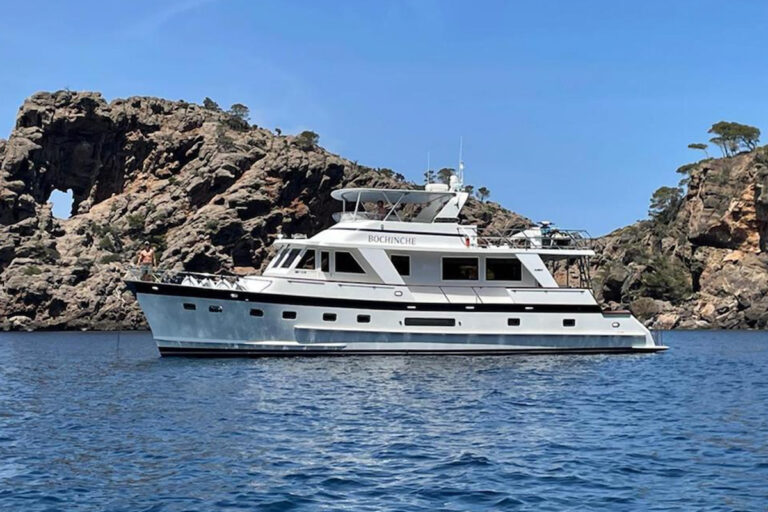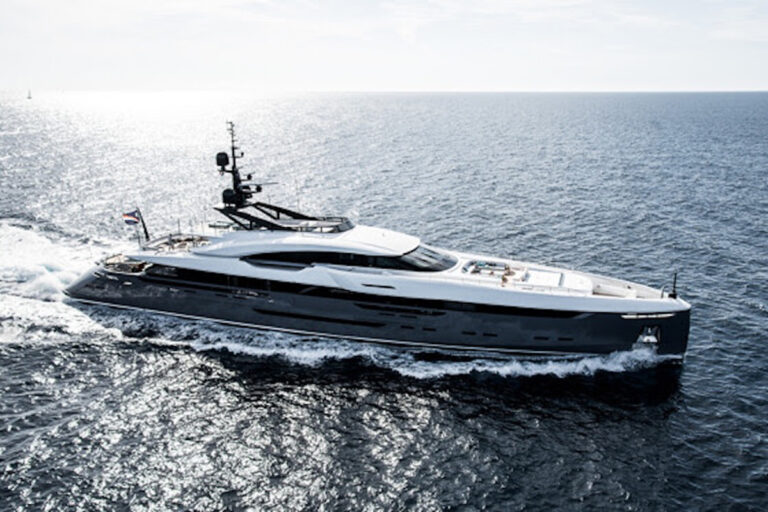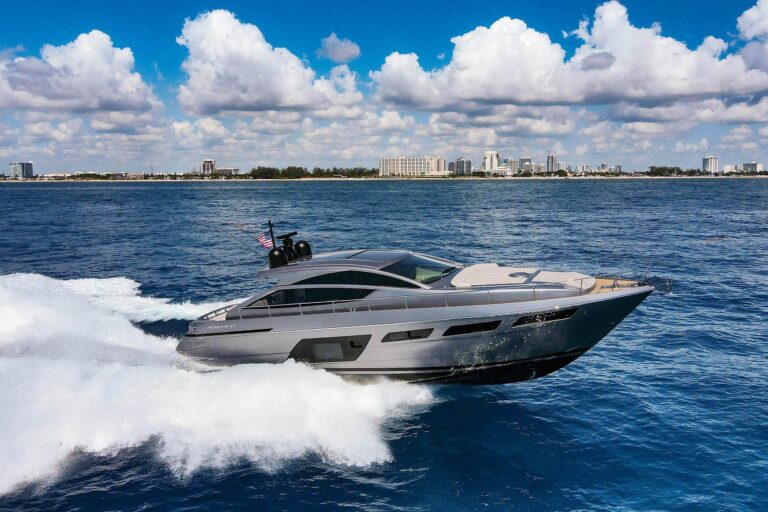No sooner had a river of fuel propelled King Juan Carlos of Spain’s 135-foot, E.N. Bazan Shipyard-built Fortuna III to a world-record speed of 68 knots than a plot was conceived to dethrone the new royalty.
The triumvirate of Millennium Super Yacht principals John Staluppi and John Rosatti, and Dutch naval architect Frank Mulder, dialed in 70 knots as the number they intended to beat, just after Fortuna III’s 2000 sea trials in Cadiz, Spain. The threesome also decided to take the unofficial worldwide competition up a few notches by designing a yacht full of luxurious creature comforts, as opposed to a stripped-down radar gun racer, and by powering her without exotic accoutrements.
“We wanted to see what we could do with reasonable and normal materials”, Mulder said.
If history is a guide, the yacht these three men intend to unveil in about 18 months should stand apart from her sisters in speed. While she is not the only speedster in production (the Wally 118 was due for sea trials around press time, chasing the 70-knot number with three Vericor TF-50 aeroderivative gas turbines), the Millennium 140 will be the product of the same team that created the 132-foot Octopussy and the 116-foot Moonraker, each dubbed the fastest superyacht of her time with speeds of 53 knots and 66.7 knots, respectively.
Mulder, of Mulder Design in the Netherlands, said the threesome began their quest by considering the obvious: length, desired speed and weight.
“We make an assessment of the size boat we are designing, and what will be necessary to accomplish our speed goals, within budget and without outrageous power requirements”, he said.
Based on previous successes, including Octopussy’s three-diesel application and Moonraker’s wing diesels and 4,500 hp turbine, they had much knowledge from which to build. They also knew they would be attempting to beat the record with a one-quarter load.
“The hull design we ultimately chose was not a radical departure from previous designs”, Mulder said. “It is relatively from the same family.”
As with many new projects and designs, equations are modified for a multitude of reasons at various stages. The 140, for example, started life as a 138. Three designs were tank-tested before the group agreed on a distinctive direction, one that will be closely guarded until the 140’s launch. Construction, expected to take 18 to 22 months, was scheduled to start during the first half of this year.
The threesome quickly dismissed the idea of powering the 140 with an unnecessarily costly, exotic, multi-turbine package. Instead, Mulder said, they turned to Paxman for the diesel portion of the speed equation, based on the weight-to-horsepower ratio the company’s engines offer. The choice was a 90-degree V-configuration producing 5,362 hp at a maximum 1950 rpm and weighing about 22,440 pounds. Compression will be 13.1:1, with a 600 rpm idle and 185-by-196 mm bore/stroke.
“We are in tune with the engine manufacturers”, Mulder said. “That package also met the height and size requirements we faced.”
Supplementing the diesels will be a pair of TF-40 Vericor turbines, configured side-by-side in a TF-80 package. Vericor is a partnership formed by Honeywell International Inc. and MTU Aero Engines GmbH, which makes the turbine line formerly known as Lycoming.
A single gear will couple the two TF-40 turbines, which have a combined weight of 2,650 pounds without the gear. The turbine will add boost after the wing diesels get the yacht up to speed.
Turbines offer the benefits of light weight and high horsepower, but the ancillary ducts, filters and gears necessary to keep them breathing add pounds to the final product. Thus, choosing a durable, lightweight hull material was key.
The men chose Alustar, a high-tensile aluminum that is said to be 20 to 30 percent stronger than other aluminum metals at identical thickness, which maintains muscle without extra baggage. The 140’s decks will be fabricated from aluminum honeycomb. Neither the generators nor the interior spaces will be shortchanged, Mulder said, holding fast to the notion of crafting an interior without aesthetic compromises.
After the hull is complete, the power will be installed. It will be flex-mounted and connected to epicyclic gears developed specifically for this project by Cincinnati Gears. The gears are engineered to be the same height as the water jets, and they are dramatically lighter than their siblings, according to Mulder. He had only praise for Cincinnati Gears and said the company’s technological advances removed any doubt about the equipment’s life span, but he had no intention of revealing the secrets behind this project’s expected success.
A standard wet system will handle diesel exhaust after it passes through Paxman’s high- and low-pressure turbines. The Vericor TF-80 will use a dry exhaust exited through the transom.
Mulder chose a water jet propulsion system. He said surface-piercing drives would have been too much of a challenge, and tunnel props fell out of the picture thanks to the “if it ain’t broke, don’t fix it axiom”. All power will be directed to three Lipps water jets, with the Paxmans pushing two LJ77Es and the TF-80 directing an LJ84E.
The designer said the choice was simply a matter of what worked best for this yacht. The Lipps jets, instead of submerging the thrust bearing, mount it forward to allow access and control. Further, Lipps and Mulder Design developed a special inlet using fluid dynamics to allow minimal, if any, distortions and greater efficiency throughout the entire power range. Again, Mulder was mum on the details.
Design, power, weight reduction and strength are the key ingredients in producing speed. In about 18 months, the world should have a pretty good indication of whether this threesome’s formula will provide the intended result.
In an age when some megayachts are beginning to buck the trend of conservation and conservatism, it will be interesting to see a little swagger at the top end of fire-breathing luxury.
Contact: Millennium Super Yachts, (561) 721-4100; fax (561) 844-9160; www.millenniumsuperyachts.com. MAN B&W-Paxman Diesels, (203) 740-0196; richard.vandam@liwave.com; www.manbwltd.com. Vericor Power, (770) 569-8800; fax (770) 560-0399; contact@vericor.com; www.vericor.com.

